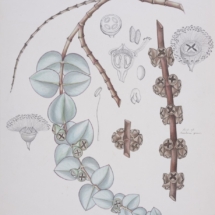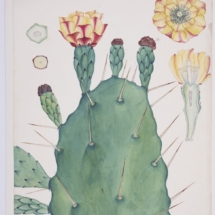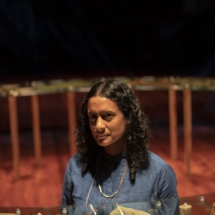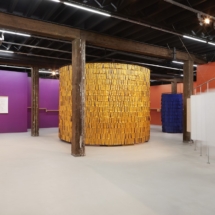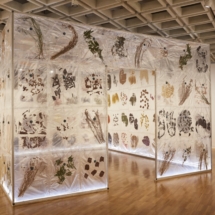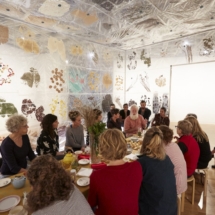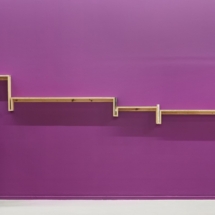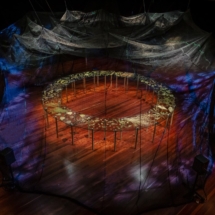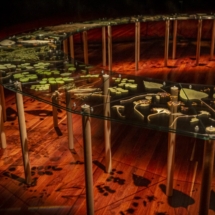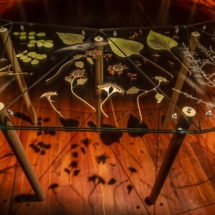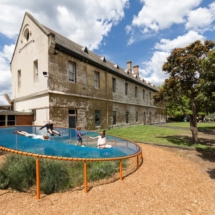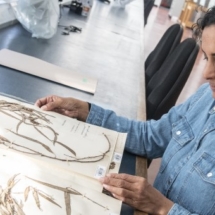Following Keg de Souza’s acclaimed international installations in Australia, North America and Asia, the artist will unveil her first major exhibition in the UK as Shipping Roots runs from 24 March to the 27th August 2023 at Inverleith House, Royal Botanic Garden Edinburgh (RBGE). Addressing the deep colonial legacy of the RBGE plant archives and Shipping Roots relates stories of plants to the artist’s own cultural removal – drawing from her lived experiences as a person of Goan heritage whose ancestral lands were colonised, to living as a settler on unceded Gadigal land in, the place known by its colonial name, Sydney. The exhibition will also be part of the 2023 Edinburgh Art Festival.
As artist in residence at the Royal Botanic Garden Edinburgh Keg De Souza spent much of 2022 studying the research institute’s living and preserved collections in preparation for her striking exploration of colonial legacies through the movement of plants between the UK, India and Australia. Shipping Roots shares lesser known plant stories moving over oceans and lands highlighting not just the political impact of these plants but the impact on climate also. de Souza has shown internationally at the Sydney Biennale, Setouchi Biennale, Japan, Jakarta Biennale and Auckland Triennial.
The result is an expansive exhibition commissioned for the Climate House programme and exploring the movement of plants throughout the British Empire including eucalyptus, prickly pear and the many seedlings transported to the UK embedded in sheep fleeces known as ‘wool shoddy aliens’. The result sees the gallery spaces of Inverleith House transformed, from whole Eucalyptus branches taken indoors to host arboreal listening posts to cochineal dyed batik artworks and play spaces for children to engage with the materials and stories of the exhibition and well as the opportunity to share rare botanical illustrations.
These lesser known stories include Blue Haze, the journey of the Eucalypt away from its culturally significant context – the Aboriginal land it comes from – at the hands of the British, and spread across the globe to eventually cover a land mass area over 22 million Hectares worldwide, leading to devastating impacts such as lowering water tables and increasing fire risk. The plant which has displaced native species in India and around the world in Australia is a very culturally and environmentally significant plant. Balancing these contrasts and sharing stories of Aboriginal fire elders as well as botanical insights, Shipping Roots draws on de Souza’s holistic practice engaging temporary architecture, politics of food, and radical pedagogy to explore colonial impact on place and communities.
Green Hell explores the failures of the British to establish a cochineal dye industry within their Empire, for wealth-building – and to dye their Redcoats the colour of blood. Prickly pear carved out scenes of Empire in multifaceted ways. As an early coloniser it arrived on the First Fleet, introduced into Australia as a habitat for the cochineal insect, and used as an agricultural fence to divide up stolen land. It thrived in drought-tolerant conditions, propagated rampantly and rapidly – overtaking the land and overshadowing native species – covering an area larger than the size of the UK only a few decades after its introduction. At the same time in India, the East India Company’s cochineal ventures were a different series of missteps and mishaps – from years of failed attempts to get cochineal insects across the sea to the subcontinent, to eventually introducing the wrong species of the insect and producing a lesser quality dye there was no market for. Their attempts in both locations were a spectacular failure, leaving lasting impacts on the land and landscape.
Fleece Fugitives looks at how the movement and spread of plants has not always been intentional. When the fleece of Australian sheep made their way across the seas the British had originally brought them over on some were carrying native seed hitchhikers, or fugitives, hidden amongst them. The woollen industry in Scotland enabled these seeds to escape through effluent from the mills and the wool waste, ‘wool shoddy’ which had the ‘alien’ seeds hidden within. These seeds propagated around the mills, an effect of industry, and went out to diversify the landscape.
Speaking ahead of the exhibition artist Keg de Souza said:
Having research time in 2022 to explore the libraries and herbarium at Royal Botanic Edinburgh and to work with the generous scientists and archivists here has been hugely rewarding. As I began to explore the stories behind these plants I discovered everything is interrelated. I want Shipping Roots to share this information and trace some of these connections whilst experiencing the stories on different levels. Stories that are lesser heard, highlighting some of the gaps in the archives. A lot of my work tries to highlight voices of marginalised people, First Nations narratives and colonised people, so I think the plants tell these and the transformation of the gallery is designed to do so in a multi-sensory way engaging with visitors of all ages.











